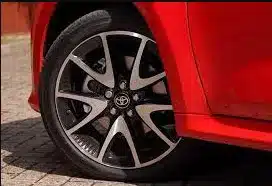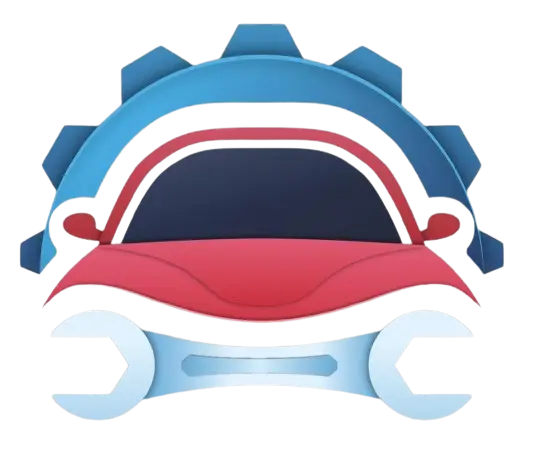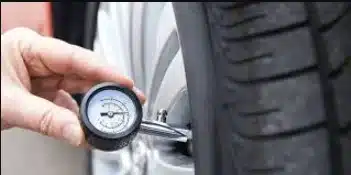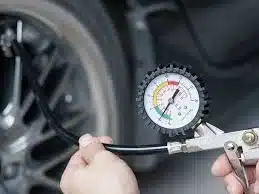Cruising down the road in your Toyota Yaris, the wind in your hair and the open road ahead. Everything’s perfect, except… are your tyres properly inflated? It might seem like a small detail, but maintaining the correct tyre pressure in your Yaris is crucial for safety, fuel efficiency, and performance.
So, how do you navigate the PSI minefield and find the sweet spot for your specific model? Worry not, fellow Yaris enthusiast, this guide is your roadmap to perfectly pressured tyres!
Finding the Right Number
First things first, ditch the guesswork. The golden source for your Yaris’ ideal tyre pressure lies not in dusty forums or whispered legends, but right within your trusty owner’s manual.
Flip to the tyre pressure section (usually near the technical specifications) and voila! There, nestled amidst oil capacities and spark plug types, you’ll find a chart tailor-made for your Yaris’ model year, tyre size, and even load conditions.
Table
| Yaris | 185/65 R15 | 2.3 bar or 33 psi | 2.2 bar or 32 psi |
| Yaris | 195/55 R16 | 2.2 bar or 32 psi | 2.0 bar or 29 psi |
| Yaris | 205/45 R17 | 2.2 bar or 32 psi | 2.0 bar or 29 psi |
| GR Yaris | 225/40 R18 | 2.2 bar or 32 psi | 2.0 bar or 29 psi |
| Yaris Cross | 205/65 R16 | 2.3 bar or 33 psi | 2.2 bar or 32 psi |
| Yaris Cross | 215/55 R17 | 2.2 bar or 32 psi | 2.0 bar or 29 psi |
| Yaris Cross | 215/50 R18 | 2.2 bar or 32 psi | 2.0 bar or 29 psi |

Decoding the Chart
The chart typically lists two tyre pressure values: one for the front and one for the rear. These are usually given in PSI (pounds per square inch) and sometimes in additional units like kPa (kilopascals) or bar.
Don’t be intimidated by the lingo, just focus on the numbers! Remember, these are the recommended cold tyre pressures, meaning you should measure them before hitting the road, not after your tyres have warmed up from driving.
Special Situations
Life on the road isn’t always smooth sailing. Sometimes, you might encounter situations that call for adjustments to your Yaris’ tyre pressure. For instance, if you’re carrying a heavy load like luggage or passengers, consider increasing the pressure by a few PSI (refer to your owner’s manual for specific recommendations).
Conversely, if the weather takes a nosedive and temperatures plummet, your tyres might lose a bit of pressure naturally. Don’t panic, just top them up to the recommended levels when things warm up again.
The Benefits of Proper Inflation
Maintaining the correct tyre pressure isn’t just about checking a box. It’s about unlocking a multitude of benefits for your Yaris and your wallet:
- Enhanced Safety: Properly inflated tyres grip the road better, improving braking performance and handling, and reducing the risk of blowouts.
- Fuel Efficiency Boost: Underinflated tyres have higher rolling resistance, meaning your engine has to work harder, costing you precious fuel. Keeping them pumped up saves you money at the pump!
- Smoother Ride: Ever felt your Yaris bouncing like a beach ball on unpaved roads? Underinflated tyres exacerbate bumps and vibrations. Optimum pressure translates to a smoother, more comfortable ride.
- Extended Tyre Life: Tyres that aren’t properly inflated wear unevenly, leading to premature replacement. By maintaining the correct pressure, you’ll squeeze out every mile from your investment.
Making it a Habit
Checking your tyre pressure might not be as thrilling as a weekend road trip, but it’s just as important. Aim to check them at least once a month, and more frequently if you’re doing a lot of driving or carrying heavy loads.
Invest in a good quality tyre pressure gauge and make it a part of your pre-drive routine. You’ll be rewarded with a safer, more fuel-efficient, and happier Yaris!
Remember: Maintaining the correct tyre pressure is a simple yet impactful way to optimize your Toyota Yaris experience. So, grab your tyre gauge, consult your owner’s manual, and get pumping! Your Yaris and your wallet will thank you for it.
Bonus Tip: Don’t forget the spare! While you’re checking the pressure in your main tyres, take a moment to top up your spare as well. You never know when it might come in handy, and running a flat spare is no fun at all.
Happy driving!


